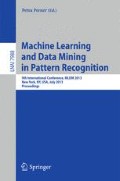Abstract
Data clustering is an important and widely used task of data mining that groups similar items together into subsets. This paper introduces a new clustering algorithm SOM++, which first uses K-Means++ method to determine the initial weight values and the starting points, and then uses Self-Organizing Map (SOM) to find the final clustering solution. The purpose of this algorithm is to provide a useful technique to improve the solution of the data clustering and data mining in terms of runtime, the rate of unstable data points and internal error. This paper also presents the comparison of our algorithm with simple SOM and K-Means + SOM by using a real world data. The results show that SOM++ has a good performance in stability and significantly outperforms three other methods training time.
Access this chapter
Tax calculation will be finalised at checkout
Purchases are for personal use only
Preview
Unable to display preview. Download preview PDF.
References
Aguado, D., Montoya, T., Borras, L., Seco, A., Ferrer, J.: Using SOM and PCA for Analysing and Interpreting Data from a P-removal SBR. Engineering Applications of Artificial Intelligence 21(6), 919–930 (2008)
Arthur, D., Vassilvitskii, S.: K-Means++ the Advantages of Careful Seeding. In: Proc. ACM-SIAM Symposium on Discrete Algorithms (SODA), pp. 1027–1035 (2007)
Attik, M., Bougrain, L., Alexandre, F.: Self-organizing map initialization. In: Duch, W., Kacprzyk, J., Oja, E., Zadrożny, S. (eds.) ICANN 2005. LNCS, vol. 3696, pp. 357–362. Springer, Heidelberg (2005)
Benabbas, F., Khadir, M.T., Fay, D., Boughrira, A.: Kohonen Map Combined to the K-Means Algorithm for the Identification of Day Types of Algerian Electricity Load. IEEE Proc. 7th Computer Information Systems and Industrial Management Applications, 78–83 (2008), doi:10.1109/CISIM.2008.27
Chi, S.-C., Yang, C.-C.: A Two-stage Clustering Method Combining Ant Colony SOM and K-means. Journal of Information Science and Engineering 24, 1445–1460 (2008)
Chi, S.-C., Yang, C.C.: Integration of Ant Colony SOM and K-Means for Clustering Analysis. In: Gabrys, B., Howlett, R.J., Jain, L.C. (eds.) KES 2006. LNCS (LNAI), vol. 4251, pp. 1–8. Springer, Heidelberg (2006)
Chiu, C.-Y., Chen, Y.-F., Kuo, I.-T., Ku, H.-C.: An Intelligent Market Segmentation System Using K-Means and Particle Swarm Optimization. Expert Systems with Applications 36(3), 4558–4565 (2008)
Chiu, C.-Y., Kuo, I.-T., Chen, P.-C.: A Market Segmentation System for Consumer Electronics Industry Using Particle Swarm Optimization and Honey Bee Mating Optimization. Global Perspective for Competitive Enterprise, Economy and Ecology pt. 12, ch. 1 (2009)
Corrêa, R.F., Ludermir, T.B.: A Hybrid SOM-Based Document Organization System. In: IEEE Proc. 9th Brazilian Symposium on Neural Networks (SBRN 2006), pp. 90–95 (2006), doi:10.1109/SBRN.2006.3
Khedairia, S., Khadir, M.T.: Self-Organizing Map and K-Means for Meteorological Day Type Identification for the Region of Annaba -Algeria-. In: IEEE Proc. 7th Computer Information Systems and Industrial Management Applications, pp. 91–96 (2008), doi:10.1109/CISIM.2008.29
Kohonen, T.: The Self-Organizing Map. Proc. of the IEEE 78(9), 1464–1479 (1990), doi:10.1109/5.58325
MacQueen, J.B.: Some Methods for Classification and Analysis of Multivariate Observations. In: Proc. of 5th Berkeley Symposium on Mathematical Statistic and Probability, vol. 1, pp. 281–297. University of California Press, Berkeley (1967)
Poelmans, J., Elzinga, P., Viaene, S., Van Hulle, M.M., Dedene, G.: How Emergent Self Organizing Maps can Help Counter Domestic Violence. In: IEEE Proc. 2009 WRI World Congress on Computer Science and Information Engineering (CSIE), Los Angeles, USA, vol. 4, pp. 126–136 (2009), doi:10.1109/CSIE.2009.299
Roussinov, D.G., Chen, H.: A Scalable Self-organizing Map Algorithm for Textual Classification: A Neural Network Approach to Thesaurus Generation. Communication and Cognition in Artificial Intelligence Journal 15(1-2), 81–111 (1998)
Sagheer, A., El., T.N., Maeda, S., Taniguchi, R., Arita, D.: Fast Competition Approach using Self Organizing Map for Lip-Reading Applications. In: IEEE Proc. International Joint Conference on Neural Network (IJCNN), pp. 3775–3782 (2006), doi:10.1109/IJCNN.2006.1716618
Souza, J.R., Ludermir, T.B., Almeida, L.M.: A Two Stage Clustering Method Combining Self-Organizing Maps and Ant K-Means. In: Alippi, C., Polycarpou, M., Panayiotou, C., Ellinas, G. (eds.) ICANN 2009, Part I. LNCS, vol. 5768, pp. 485–494. Springer, Heidelberg (2009)
Su, M.-C., Liu, T.-K., Chang, H.T.: Improving the self-organizing feature map algorithm using an efficient initialization scheme. Tamkang Journal of Science and Engineering 5(1), 35–48 (2002)
Wolberg, W.H.: Breast Cancer Wisconsin (Original) Dataset (1992), http://archive.ics.uci.edu/ml/datasets/Breast+Cancer+Wisconsin+%28Original%29
Yang, Y., Rong, L.: Establishment of the Evaluation Index System of Emergency Plans Based on Hybrid of SOM Network and K-means Algorithm. In: IEEE Proc. 4th International Conference on Natural Computation, pp. 347–351 (2008), doi:10.1109/ICNC.2008.454
Author information
Authors and Affiliations
Editor information
Editors and Affiliations
Rights and permissions
Copyright information
© 2013 Springer-Verlag Berlin Heidelberg
About this paper
Cite this paper
Dogan, Y., Birant, D., Kut, A. (2013). SOM++: Integration of Self-Organizing Map and K-Means++ Algorithms. In: Perner, P. (eds) Machine Learning and Data Mining in Pattern Recognition. MLDM 2013. Lecture Notes in Computer Science(), vol 7988. Springer, Berlin, Heidelberg. https://doi.org/10.1007/978-3-642-39712-7_19
Download citation
DOI: https://doi.org/10.1007/978-3-642-39712-7_19
Publisher Name: Springer, Berlin, Heidelberg
Print ISBN: 978-3-642-39711-0
Online ISBN: 978-3-642-39712-7
eBook Packages: Computer ScienceComputer Science (R0)

